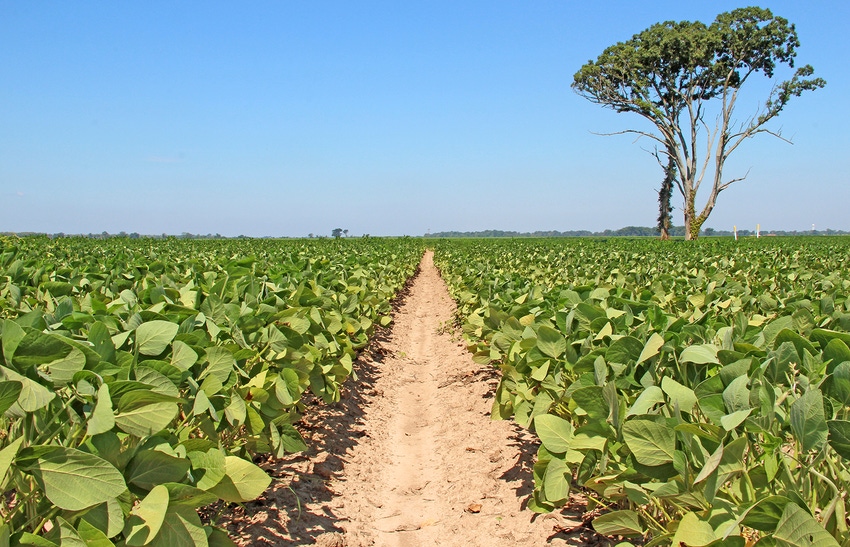March 3, 2021

Soybeans, compared to other major crops in the Mid-South, are capable of being planted across a wider range of calendar dates while requiring three to four times the seeds per acre and having the flexibility of being planted on row spacings ranging from 7.5-inch ultra-narrow rows to 38-inch wide rows.
What does this mean in terms of reaching top end yield goals? Sometimes it means that things can just simply be confusing.
The following are some considerations intended to narrow down the best management practices that will contribute to maximizing soybean yield and ultimately profitability.
There are lots of reasons for the improved yields that have been observed over the last decade, but to put it simply, best management practices are key.
The Mississippi Soybean Promotion Board (MSPB) sponsors research and demonstration programs that focus on finding solutions and aiding in adoption of such best management practices. With funding help from the Mississippi soybean checkoff program, research trials and demonstration programs have focused on variety performance evaluations as well as the impact that the planting date, seeding rate and row spacing have on soybean yield.
Variety selection
A management decision as important as variety selection should not be taken lightly. Other than the planting date, no other management decision will make such a direct impact on overall yield potential.
There are numerous varieties available on the market today. Often, those varieties that we become comfortable with are quickly replaced with something even better.
Reviewing results from variety trials and demonstration programs will help in selecting appropriate varieties for your farm.
There are numerous resources available regarding soybean variety performance. For example, the current year’s results from on-farm variety performance evaluations as well as previous year’s summaries can be accessed through the Mississippi Crop Situation site, while results from small plot variety testing in Mississippi can be found on the Mississippi Agricultural and Forestry Experiment Station (MAFES) Official Variety Trial site.
The MSPB Variety Selector tool includes data from hundreds of soybean varieties across multiple years and locations.
The bottom line is that variety performance data are readily available, and these and other resources should be consulted in order to make the most informed decision about which varieties fit for a given production setting.
Planting date
The soybean planting date can arguably be said to be equally as important as variety selection. Numerous research trials have demonstrated that the Early Soybean Production System (ESPS) is capable of enhancing yield and overall profitability. In Mississippi, soybeans planted in April hold a distinct yield advantage over soybeans planted in May or June.
Unfortunately, we cannot control environment conditions at planting, but the bottom line is this: Once the month of April arrives and soil temperatures reach appropriate values, if it is possible to get into the field to plant soybeans, you will set yourself up for maximum yield by doing so.
Seeding rate
Soybean seeding rate decisions can be further complicated by planting date and even soil texture. For example, if planting early in the window when temperatures are cool and soil conditions are more consistently on the wet side, you may benefit from a higher seeding rate that will help you achieve an adequate stand the first time you plant.
On the other hand, once temperatures climb and soil moisture conditions are ideal for germination, seeding rate can be reduced. With respect to soil texture, higher seeding rates may be required if planting on a heavy clay soil compared to lower seeding rates being adequate on sandy soils.
Specifically, if planting during the early part of the planting window when cooler temperatures and wetter soil conditions are prevalent (common conditions during the month of April), consider seeding soybeans at 130,000 to 140,000 seeds per acre. If planting during the middle portion of the planting window when temperatures are more moderate and soil moisture conditions are ideal, consider reducing the seeding rate to 120,000 to 130,000 seeds per acre.
Row spacing

Numerous trials have been conducted over the years evaluating soybean yield response to row spacing. Generally speaking, in an irrigated production system, soybean yield will be greater on narrow rows than wide rows. In a non-irrigated production system, this response varies, likely depending on rainfall accumulation and overall yield potential of the crop.
Let’s talk specific scenarios for a moment. Potential advantages that come along with narrow row soybean production might include improved yield potential and faster canopy closure that could mean fewer herbicide applications and improved water use efficiency. Potential disadvantages might include increased equipment costs and challenges implementing irrigation, particularly in areas where furrow irrigation is the primary irrigation delivery method.
The bottom line for row spacing is that often it becomes a matter of convenience for the producer. As most producers grow more than one commodity, adopting a soybean row spacing that is complementary to other commodities grown on that farm makes sense. For most Mississippi producers, this means 30-inch row spacing or 38-inch, twin or single row spacing.
While there may not be a one-size-fits-all answer, resources are available to help fine-tune these and other recommendations for successful soybean production. With funding help from the Mississippi Soybean Checkoff program, research trials and demonstration programs are conducted annually in order to continue to refine recommendations for best management practices necessary to maximize soybean yield potential and, more importantly, profitability.
Editor’s note: Trent Irby is the Extension Soybean Specialist with Mississippi State University. You can reach him at [email protected].
Source: The Mississippi Soybean Promotion Board, which is solely responsible for the information provided and is wholly owned by the source. Informa Business Media and all its subsidiaries are not responsible for any of the content contained in this information asset.
You May Also Like




